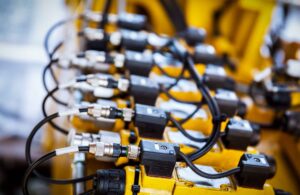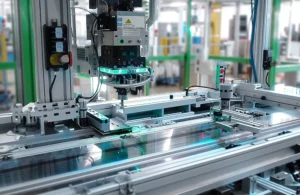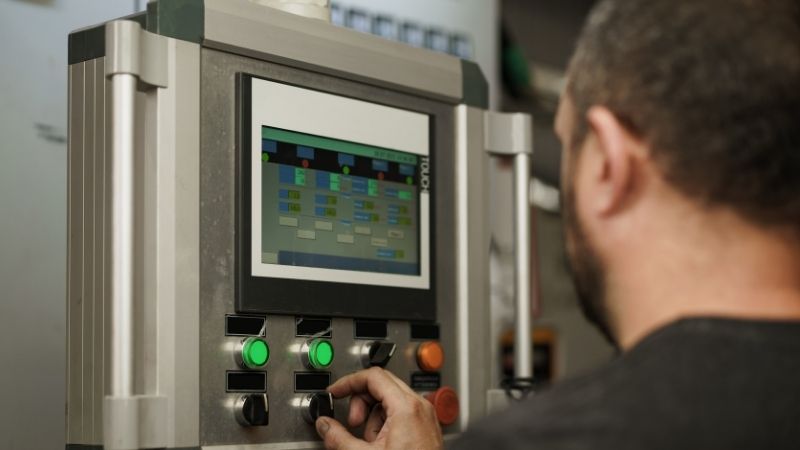PLC Solenoid Valfi Nasıl Kontrol Eder?
Neyse ki, Programlanabilir Mantık Denetleyicisi kullanarak (PLC) bu süreci hızlandırabilir, hassasiyet ve verimlilik sağlayabilir.
Kwoco'da bir mühendis olarak, PLC'lerin otomasyon görevlerini nasıl basitleştirdiğini ilk elden gördüm. Bir PLC'yi bir solenoid valfe bağlayarak, aksi takdirde manuel müdahale gerektirecek işlemleri otomatikleştirebiliriz. Bu yalnızca zamandan tasarruf sağlamakla kalmaz, aynı zamanda potansiyel olarak tehlikeli ortamlarda güvenliği de artırır.
İçindekiler
Solenoid Valf Nedir?
Solenoid valf, sıvıların ve gazların akışını kontrol eden bir elektromekanik cihazdır. İki ana parçadan oluşur: bir solenoid bobini ve bir valf gövdesi. Tasarıma bağlı olarak, bir solenoid valf normalde açık (NO) veya normalde kapalı (NC) olabilir. Bu, sürekli manuel ayarlamalar gerektirmeden sıvı akışına izin verdiği veya akışı engellediği anlamına gelir.
Solenoid bobin enerjilendirildiğinde, valf gövdesi içindeki pistonu hareket ettiren bir manyetik alan yaratır. Bu eylem valfi açar veya kapatır ve medyanın akışını kontrol eder. Bu mekanizmayı anlamak, akışkan kontrol sistemlerinde çalışan herhangi bir mühendis için önemlidir.
Solenoid Valf Seçerken Hangi Faktörleri Göz Önünde Bulundurmalısınız?
Solenoid valf seçimi söz konusu olduğunda, mevcut seçenekler karşısında bunalmış hissedebilirsiniz. Doğru valfi seçmek çok önemlidir, çünkü yanlış seçim operasyonel verimsizliklere ve artan maliyetlere yol açabilir. Neye bakmanız gerektiğini anlamak bu süreci basitleştirebilir.
Basitçe ifade etmek gerekirse, dikkate alınması gereken temel faktörler şunlardır:
- Solenoid Vana Tipi: İki yollu, üç yollu veya dört yollu bir vanaya ihtiyacınız olup olmadığını düşünün. Bu, uygulamanıza ve istenen akış kontrolüne bağlıdır.
- Çalışma Basıncı ve Sıcaklığı: Vananın sisteminizin basınç ve sıcaklık koşullarını kaldırabildiğinden emin olun. Bu sınırların aşılması vana arızasına veya güvenli olmayan işlemlere yol açabilir.
- Medya Uyumluluğu: Vana malzemesinin kontrol edeceği sıvılar veya gazlarla uyumlu olduğundan emin olun. Vanaya zarar verebilecek kimyasal reaksiyonlardan kaçınmak esastır.
- Voltaj Gereksinimleri: AC veya DC vanaya ihtiyacınız olup olmadığını belirleyin ve çalışma için gereken voltajı kontrol edin. Bu, kurulumu ve mevcut sistemlerinizle entegrasyonu etkileyebilir.
- Yanıt Süresi: Hızlı çalıştırma gerektiren uygulamalar için, vananın tepki süresini göz önünde bulundurun. Bu, sisteminizin genel verimliliğini etkileyebilir.
- Boyut ve Akış Hızı: Vana boyutu boru sisteminizle eşleşmeli ve akış hızı uygulamanızın gereksinimlerini karşılamalıdır. Uygunsuz şekilde boyutlandırılmış vanalar verimliliği azaltabilir veya aşınmayı artırabilir.
- Kalite ve Güvenilirlik: Kalitesiyle bilinen saygın üreticilerin vanalarını seçin. Kalite, bakım maliyetlerini ve operasyonel güvenilirliği etkiler.
- Maliyet ve Değer: Bütçe kısıtlamaları önemli olsa da, bir vananın performans ve uzun ömür açısından sunduğu genel değeri göz önünde bulundurun. Kaliteli ürünlere yatırım yapmak uzun vadeli tasarruflara yol açabilir.
Bu faktörleri aklınızda tutarak projenizin başarısını artıracak bilinçli bir karar verebilirsiniz.
PLC'ler Solenoid Valflerle Nasıl Çalışır?
Solenoid valfler hemen hemen her akışkan kontrol sisteminde hayati öneme sahiptir. Sıvıların ve gazların akışını otomatikleştirerek zamandan tasarruf sağlar ve insan hatası riskini azaltır. Hassas kontrol için, bir solenoid valfi yönetmek için bir PLC kullanmak akıllıca bir seçimdir.
Bir PLC bir voltaj çıkışı verdiğinde, solenoidi enerjilendirir ve sıvının akmasını sağlar. Tersine, voltajı kesmek solenoidi devre dışı bırakarak akışı durdurur. Bu basit ancak etkili kontrol mekanizması çeşitli endüstriyel uygulamalarda anahtardır.
Bir PLC'yi bir solenoid valfe nasıl bağlayacağınızı anlamak, sisteminizin performansını büyük ölçüde artırabilir. PLC'nin çıkış modülü doğrudan solenoid valfin bobinine bağlanır. Uygun çıkış noktası voltaj aldığında, solenoid bobini etkinleşerek valfi devreye sokar.
24V solenoidler gibi yüksek akım gerektiren kurulumlar için yükü güvenli bir şekilde yönetmek için harici güç kaynakları ve ara röleler kullanın. Bu, PLC'nizin kısa devreler sırasında bile korunmasını ve çalışır durumda kalmasını sağlar.
Projelerinize yepyeni, orijinal Omron, Mitsubishi, Schneider PLC'lerle güç katın - stokta, hemen kullanıma hazır!
Çözüm
Bir solenoid valfi PLC ile kontrol etmek, akışkan kontrol sistemlerini otomatikleştirmenin etkili bir yoludur. Çalışma prensiplerini anlayarak, proje sonuçlarınızı iyileştirebilir ve güvenlik ve güvenilirliği sağlayabilirsiniz.
Projeleriniz için yeni, orijinal PLC'ler mi arıyorsunuz? Kwoco'da, en iyi markaların en son PLC'lerini stoklarız: Omron, Mitsubishi, Ve Schneider. Güvenle alışveriş yapın - hızlı kargo, garantili kalite! Hemen satın alın.
Bize Ulaşın
Bu forma adınızı, e-posta adresinizi ve sorunuzun kısa bir açıklamasını girmeniz yeterlidir. 24 saat içinde sizinle iletişime geçeceğiz.
Bu Konuları da İlginizi Çekebilir

Sensörlerin Gücünü Keşfetmek: Türleri, Kullanımları ve Uygulamaları
Sensörler her yerimizde, hayatımızı daha rahat, verimli ve güvenli hale getirmek için sahne arkasında sessizce çalışıyorlar. Bir odaya girdiğimizde ışıkları yakmaktan araçlarımızda güvenliği sağlamaya kadar sensörler modern teknolojinin ayrılmaz bir parçasıdır.

Servo Motorlarda Bilmeniz Gereken 5 Tip Enkoder
Endüstriyel otomasyonda kapsamlı deneyime sahip bir mühendis olarak, servo motorlar ve kullandıkları kodlayıcılar hakkında derin bir anlayışa sahibim. Servo sistemler otomasyonda yaygın olarak uygulanır ve kodlayıcılar, hızı ve konumu doğru bir şekilde kontrol etmek için temel bileşenler olarak hizmet eder.

İtalya'daki En İyi Altı Omron PLC Tedarikçisi
İtalya'daki En İyi Altı Omron PLC Tedarikçisi Endüstriyel otomasyon sektöründe, özellikle uluslararası ticarette derinlemesine yer alan biri olarak





